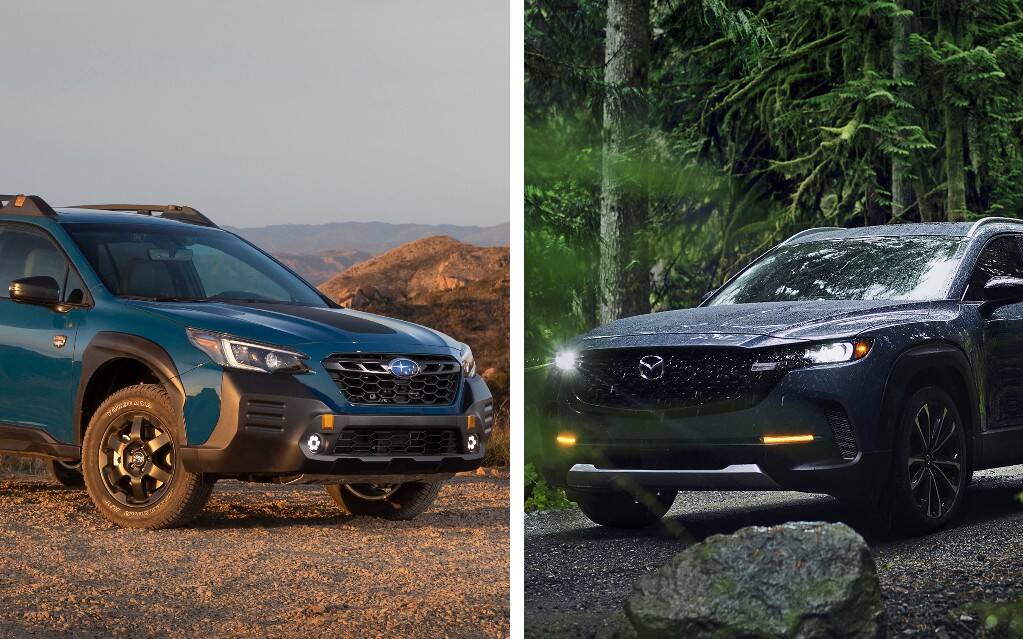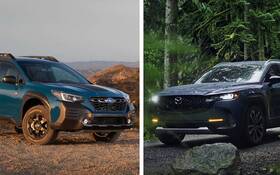2022 Subaru Outback vs. 2023 Mazda CX-50: The Numbers
The all-new 2023 Mazda CX-50 is arriving at Canadian dealerships in May and a lot of people are buzzing about this latest addition to Mazda’s crossover lineup. It’s a bit larger and more adventure-ready than the popular Mazda CX-5, making it a direct threat to the Subaru Outback.
How do these two vehicles stack up against each other? Which one is better at what? We’ve compared the numbers and specs. Here’s what we found…
- Also: 2023 Mazda CX-50: Mazda's Answer to the Outback
- Also: The Car Guide's Best Buys for 2022: Subaru Outback
Powertrain: Tie

The Mazda CX-50 and Subaru Outback are pretty similar under the hood with a choice of naturally aspirated and turbocharged engines.
In Convenience, Touring, Limited and Premier trim, the Outback uses a 2.5-litre four-cylinder engine rated at 182 horsepower and 176 pound-feet of torque. Wilderness, Limited XT and Premier XT models get a turbocharged 2.4-litre mill putting out 260 horsepower and 277 pound-feet of torque.
Meanwhile, the CX-50 GS-L and GT also offer a 2.5-litre four-cylinder engine, this one delivering 187 horsepower and 186 pound-feet of torque. A turbocharged variant increases output to 256 horsepower and 310 pound-feet of torque when premium gasoline (93 octane) is used.
Both models come standard with all-wheel drive. The Outback has a continuously variable transmission with eight simulated gears, while the CX-50 relies on a conventional six-speed automatic. In the powertrain department, they are simply equals.
Fuel Economy: Outback

The Subaru Outback’s fuel consumption ratings are slightly better than those of the Mazda CX-50 except for the new Wilderness.
With the Outback, expect to achieve 8.2-9.1 L/100 km combined depending on engine selection. As for the CX-50, you’re looking more at 8.9-9.4 L/100 km.
Cargo and Towing: Outback

Subaru wins this battle hands down. The Outback has a 920-litre cargo area that expands to 2,144 litres when the rear seats are folded. The CX-50 has a decent trunk at 878 litres, but dropping the rear seats only gives you 1,586 litres.
When it comes to towing, the naturally aspirated engines are good for 2,700 pounds (Outback) and 2,000 pounds (CX-50). The turbos are each capable of towing up to 3,500 pounds.
Safety: Tie

Always a leader in safety, it’s no surprise that the 2022 Subaru Outback received a Top Safety Pick+ rating from the U.S. Insurance Institute for Highway Safety (IIHS).
That same organization has yet to evaluate the 2023 Mazda CX-50. However, the closely related CX-5 is a Top Safety Pick+, too.
Both models offer an extensive suite of advanced driver assistance systems—EyeSight for the Outback and i-Activesense for the CX-50—including blind spot monitoring, rear cross traffic alert, emergency braking assist with pedestrian detection and lane keeping assist.
Technology: Tie

Subaru Outback drivers face a set of analog gauges with a 4.2-litre display, complete with a 7- or 11.6-inch centre touchscreen. Apple CarPlay and Android Auto come standard, while wireless smartphone charging and a 12-speaker Harman Kardon audio system are available.
In the Mazda CX-50, the instruments come alive on a 7-inch digital display flanked by analog gauges. Infotainment goes through a 10.25-inch display. Wireless Apple CarPlay and Android Auto are included. Customers need to pay extra bucks for wireless charging and a 12-speaker Bose stereo.
There’s no real winner, here, so it’s all about one’s preferences.
Price: Outback

Subaru offers way more Outback models than Mazda does with the CX-50, at least for now. Also, pricing is cheaper, even for similar equipment. Below is the complete breakdown.
Mazda CX-50
- GS-L: $37,900
- GT: $42,850
- GT Turbo: $45,350
- Meridian: TBD
Subaru Outback
- Convenience: $31,195
- Touring: $35,395
- Limited: $39,595
- Premier: $41,395
- Wilderness: $41,995
- Limited XT: $42,395
- Premier XT: $44,195
Warranty: CX-50

Both Subaru and Mazda offer limited vehicle and powertrain coverage for three years and five years, respectively. However, the former stops at 60,000 km and 100,000 km, while the latter gives you unlimited km.
Rust perforation coverage at Subaru is five years or 100,000 km. Mazda’s is good for seven years and unlimited km.












